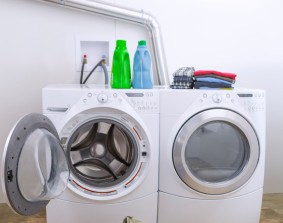Source: J.T Gonzales, http://www.angieslist.com/articles/5-common-washer-dryer-repair-problems.htm
Here are tips on troubleshooting troubles with clothes washers and dryers. You may still need to hire an appliance repair service, but the problem may be something minor you can fix yourself without the expense of a service call. Depending on the age of the appliance and seriousness of the problem, it may be time to replace the machine. According to a study by the National Association of Home Builders, the life expectancy of a washer is 10 years and of a dryer is 13 years.
1. The machine is not turning on
Sometimes the problem is something as simple as the machine not receiving power, which can be caused by a faulty outlet, a circuit breaker that has tripped, or mechanical timers and knobs that have stopped working.
If the machine is under constant heavy use, its motor can overheat and momentarily stop working. If, after giving the motor time to properly cool down, it again fails to turn on, contact a professional to address the situation. The machine could be affected by more serious issues, such as a faulty thermal fuse, thermostats, or switch. An experienced repairman can fix the problem quickly.
2. The machine fails to spin or tumble
The most common reason for this is a broken or loose belt. When the belt is the culprit, you can hear the motor running even though the machine’s drum is not spinning. A loose, snapped or worn belt needs to be changed.
If the door does not properly close or the door’s switch is not working, it will stop the machine from spinning. In a washer, the lid switch prevents you from putting a hand inside a spinning washer; that is why the machine stops when you open the lid. If the lid switch malfunctions, the washer will not spin.
Other more serious problems are issues with a washer’s transmission or clutch or a dryer’s pulley, glides or drum rollers.
3. The dryer produces little or no heat
The dryer will produce little to no heat if it can’t get the right amount of air (usually through the front). Proper airflow is crucial.
Also, if your settings (amount of time, type of fabric, temperature, etc.) do not correspond to the kind of clothes or fabrics you are drying, the dryer will appear ineffective. Perhaps you have too many clothes in the dryer? Did the clothes rinse properly in the washer?
A malfunctioning heating element, ignitor, or thermal fuse can cause a dryer to stop producing heat and will require professional help. A heating element can break or burn, the ignitor can also break or develop white or yellowish deposits that hamper its function and the thermal fuse can blow.
4. The washer won’t drain
Kinks and lint filters on the hose are common culprits, as is the hose not sitting above the level of water in the tub.
A malfunctioning water pump can also be the culprit. Removal and replacement requires an experienced person.
5. The washer leaks water
Bad seals or gaskets can cause a washer to leak water. The tub has a main seal that can begin to leak after heavy use. A bad main seal usually requires professional help to replace.
Leaks on a front-load washer are caused by the door’s seal. If it continues to leak after a good cleaning, have the gasket replaced to ensure a proper, tight seal when the door is closed.
A water pump with a bad seal will let water drip out and needs to be fixed.
